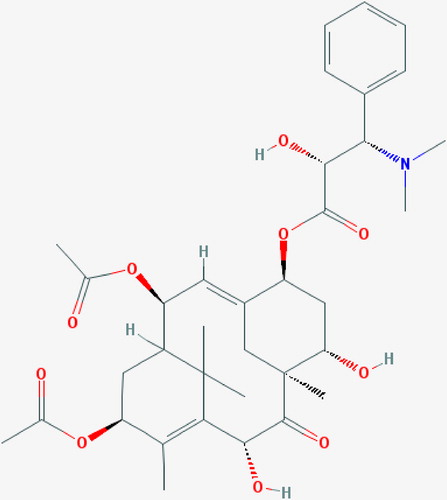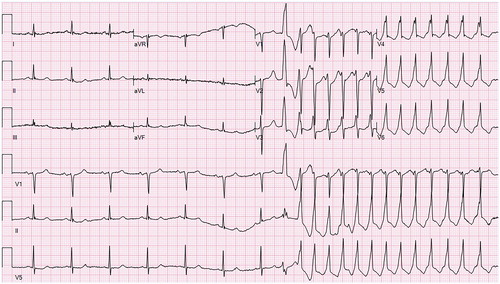Abstract
We present a case of Taxus canadensis toxicity in a suicide attempt who recovered with supportive care. Taxus canadensis is an ornamental containing cardiotoxic taxine alkaloids that affect myocardial sodium and calcium channels. A 48-year-old woman with a past medical history of depression presented to the emergency department (ED) after eating a handful of branches, leaves, and berries from a yew plant in a suicide attempt 1 h prior to arrival. In the ED, she had a blood pressure of 75/57 mmHg and heart rate of 39 bpm. Her vital signs improved with 2 L of IV fluids and 0.5 mg of IV atropine. Thirty minutes later, her heart rate increased to 180 bpm into a wide-complex ventricular tachycardia with a QRS of 142 ms, and her blood pressure decreased to 80/55 mmHg. She underwent electrical cardioversion back to normal sinus rhythm, followed by amiodarone bolus and infusion. We also discuss alternative options for treatment in the setting of yew plant toxicity.
Background
Taxus canadensis is a slow-growing, long-lived plant used ubiquitously for ornamental landscaping [Citation1]. The tree is shaped like an evergreen with a dark brown, scaly bark, and flat, dark green leaves. The toxic components, the taxine alkaloids A and B, are found in most parts of the plant, all but sparing the red flesh seed-covering aril [Citation2]. The single seed that the aril encloses is also poisonous, with the leaves the most toxic part of the plant. The taxine alkaloids () primarily affect myocardial sodium and calcium channels, causing sodium channel blockade as well as increased myocardial cell calcium levels, and can result in life-threatening dysrhythmias [Citation2,Citation3].
Case report
A 48-year-old woman with a past medical history of depression presented to the emergency department (ED) after being found by emergency medical services (EMS) in a park eating approximately a handful of branches, leaves, and berries from a yew plant in a suicide attempt roughly 1 h prior to arrival. Park officials confirmed the identification of the yew plant described in this case as T. canadensis.
In the ED, she was awake, alert, and oriented, hypothermic at 95.5 °F (35.3 °C), hypotensive with a blood pressure of 75/57 mmHg, and bradycardic with a heart rate of 39 beats per minutes (bpm). We attributed hypothermia to cold ambient environmental temperatures and sparse clothing, as her temperature normalized to 98 °F (36.7 °C) immediately with warm blankets. Her remaining vital signs temporarily improved with 2 L of warm intravenous (IV) fluids and 0.5 mg of IV atropine. Her heart rate subsequently stabilized to 77 bpm and blood pressure to 101/65 mmHg. However, 30 min after, her heart rate increased further to 180 bpm into a wide-complex ventricular tachycardia, with QRS of 142 ms (), and her blood pressure decreased to 80/55 mmHg. She underwent electrical cardioversion, which immediately converted her to normal sinus rhythm, and then received a 150 mg bolus of IV amiodarone.
After 1 h in the ED, she had pulseless ventricular tachycardia, requiring defibrillation, cardiopulmonary resuscitation, and IV epinephrine. She received IV calcium gluconate, magnesium sulfate, and sodium bicarbonate. The patient remained unresponsive after return of spontaneous circulation, and she remained hypotensive. She underwent endotracheal intubation and received infusions of norepinephrine, amiodarone, and sodium bicarbonate before admission to the intensive care unit (ICU). Initial laboratory analysis prior to cardiac arrest including complete blood count, and basic metabolic panel were unremarkable. The only abnormality was an elevated serum lactate of 4.7 mmol/L (reference 0.5–1.0 mmol/L). On day two of hospitalization, the patient was gradually weaned off of amiodarone, sodium bicarbonate, and norepinephrine infusions. Electrocardiogram following resolution of toxicity showed a residual first-degree atrioventricular block with no QRS or QTc prolongation. Following extubation on hospital day three, the patient was transferred in stable condition to inpatient psychiatric care.
Discussion
Taxine alkaloids A and B cause myocardial sodium channel blockade, leading to QRS widening and most commonly, ventricular tachycardia [Citation4,Citation5]. Bradycardia and hypotension eventually ensue if left untreated. The taxine alkaloids also inhibit L-type calcium channels, contributing to hypotension.
Von der Werth and Murphy described a case of a 16-year-old girl who intentionally ingested a handful of leaves of the English yew (Taxus baccata), resulting in self-terminating ventricular tachycardia [Citation6]. Another case of English yew ingestion involved a 20-year-old woman who created a liquid concoction of T. baccata leaves, causing hypotension, first degree AV block, wide QRS and prolonged QTc that also self-resolved [Citation6]. Treatment of cardiotoxicty from yew plant ingestion includes initial supportive care with IV fluids, electrolyte repletion, and transcutaneous or transvenous external cardiac pacing, as well as cardioversion, defibrillation and cardiopulmonary resuscitation if warranted. Extracorporeal membrane oxygen therapy (ECMO) may be necessary in cases of refractory cardiac instability [Citation7,Citation8]. In a case of decorative ornamental shrub ingestion, T. canadensis, a 5-year-old girl developed hypotension and third degree AV block with wide complex tachycardia and received atropine and transcutaneous external cardiac pacing [Citation9]. Minimal improvement in cardiac contractility occurred with supportive care, and she improved after IV digoxin-specific Fab antibody fragments given based upon similar features to cardiac glycoside poisoning [Citation9].
Conclusion
We present a case of T. canadensis toxicity resulting from the suicidal ingestion of its leaves and seeds. With diligent supportive care (amiodarone, norepinephrine, and sodium bicarbonate), she recovered without further sequelae.
| Abbreviations | ||
| = | Yew, Taxus, Taxine | |
Disclosure statement
No potential conflict of interest was reported by the authors.
References
- Shannon MW, Borron SW, Burns MJ, editors. Poisonous plants. Clinical management of poisoning and drug overdose. 4th ed. Philadelphia (PA): Saunders Elsevier; 2007. p. 473–501.
- Krenzelok EP, Jacobsen TD, Aronis J. Is the yew really poisonous to you? J Toxicol Clin Toxicol. 1998;36:219–223.
- Kim S, Thiessen PA, Bolton EE, et al. PubChem substance and compound databases. Nucleic Acids Res. 2016;44:D1202–D1213.
- Wilson CR, Sauer J, Hooser SB. Taxines: a review of the mechanism and toxicity of yew (Taxus spp.) alkaloids. Toxicon. 2001;39:175–185.
- Shi Q-W, Si X-T, Zhao Y-M, et al . Two new alkaloidal taxoids from the needles of Taxus canadensis. Biosci Biotechnol Biochem. 2006;70:732–736.
- Von der Werth J, Murphy JJ. Cardiovascular toxicity associated with yew leaf ingestion. Br Heart J. 1994;72:92–93.
- Piskac O, Stribrny J, Rakovcova H, et al. Cardiotoxicity of yew. Cor Vasa. 2015;57:e234–e238.
- Panzeri C, Bacis G, Ferri F, et al. Extracorporeal life support in a severe Taxus baccata poisoning. Clin Toxicol (Phila). 2010;48:463–465.
- Cummins RO, Haulman J, Quan L, et al. Near-fatal yew berry intoxication treated with external cardiac pacing and digoxin-specific FAB antibody fragments. Ann Emerg Med. 1990;19:38–43.


